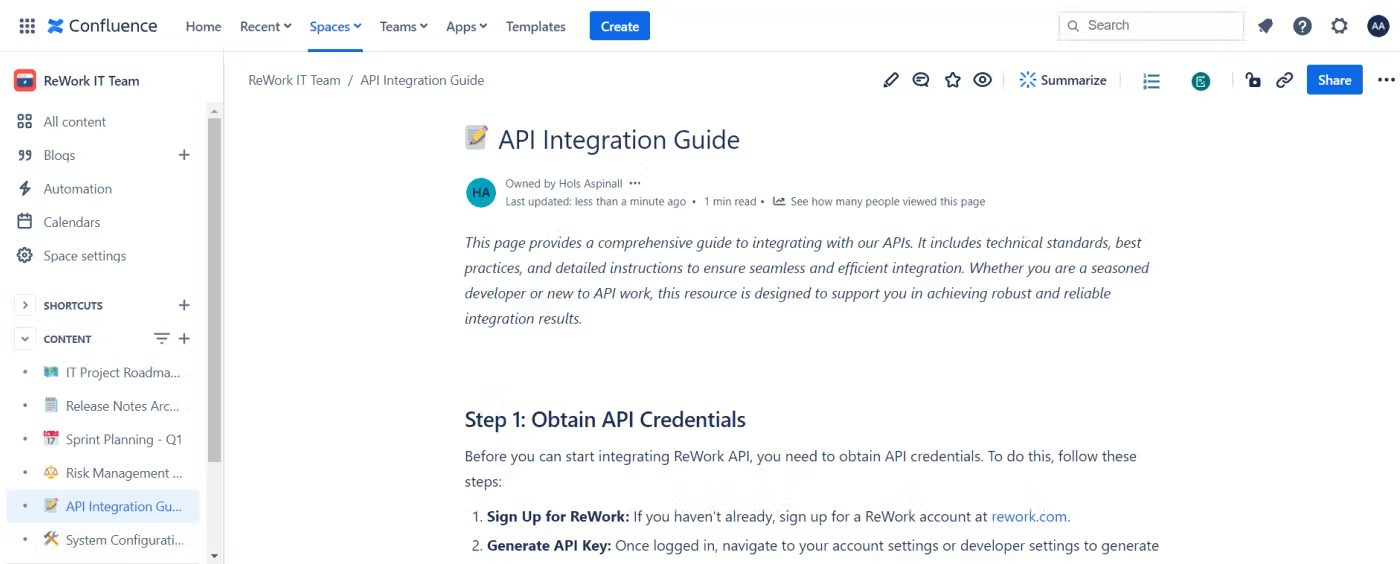Jira vs Confluence: which is right for you?
Share on socials
Jira vs Confluence: which is right for you?

Jump to Section
Jump to section
1. Focus and functionality
2. Features
3. User interface and navigation
4. Integration capabilities
5. Use cases
Conclusion
We compare Jira and Confluence on 5 key areas to help you decide the best tool for you and your organisation.
The abundance of collaboration tools available today can be confusing. How do you decide which tool is right for your team's needs? This is especially true when it comes to choosing between Atlassian’s Jira and Confluence. But don’t worry! We’re here to help untangle both platforms for you so you can make the right decision.
Want to learn more about Confluence? Check out our guide What is Confluence? for more answers.
Want to learn more about Confluence? Check out our guide What is Confluence? for more answers.
1. Focus and functionality
Jira
Jira is designed to meet the needs of agile development teams. It's all about keeping projects organised, tasks on track, and teams aligned. Jira's core functionalities revolve around task tracking, workflow management, and issue resolution, making it indispensable for teams striving for efficiency and productivity.
Confluence
Confluence takes a different approach, serving as a collaboration hub for teams to share knowledge, collaborate on projects, and communicate effectively. Confluence makes it easy to create and share documentation, meeting notes, and other essential content within teams.
Summary:
Jira is great for task tracking, workflow management, and issue resolution, while Confluence is ideal for knowledge sharing and communication.
2. Features
Jira
Jira provides a streamlined approach to project management and task management with a variety of features:
- Agile Boards: These boards offer visual representations of tasks, aiding in prioritisation and progress tracking.
- Customisable Workflows: Teams can tailor processes to their specific needs, ensuring efficient task management.
- Issue Tracking: Tasks and issues can be managed centrally, facilitating organisation and collaboration.
- Reporting and Analytics: Jira offers robust reporting tools to monitor metrics and gain valuable insights into project progress.
Confluence
Confluence focuses on collaborative content creation, offering a range of features to support teamwork:
- Rich Text Editor: Create and format content effortlessly, enabling clear communication and documentation.
- Page Hierarchy: Organise content logically within a hierarchical structure, making it easy to navigate and locate information.
- Collaborative Editing: Work together on documents in real time, fostering teamwork and creativity.
- Version History: Track changes over time and revert to previous versions if necessary.
Summary:
Jira and Confluence each offer a suite of features tailored to different aspects of project management and collaboration. Jira excels in task tracking and workflow management, while Confluence provides robust tools for collaborative content creation and organisation.
3. User interface and navigation
Jira
When you log into Jira, there is a board-centric interface that puts your project's tasks front and centre. The agile board provides a visual representation of your project's workflow, with columns representing different stages such as "To Do", "In Progress", and "Done". This allows teams to track progress, prioritise tasks, and identify roadblocks at a glance, streamlining project management processes and improving team collaboration.
Jira offers customisable dashboards that allow team members to create personalised views of their tasks, deadlines, and progress. Whether you're a developer, project manager, or stakeholder, Jira's intuitive interface makes it easy to find the information you need and stay informed about your project's status.
Jira offers customisable dashboards that allow team members to create personalised views of their tasks, deadlines, and progress. Whether you're a developer, project manager, or stakeholder, Jira's intuitive interface makes it easy to find the information you need and stay informed about your project's status.

Confluence
Confluence takes a different approach to navigation, offering a document-centric interface that emphasises content creation and organisation. When you log into Confluence, you're presented with a hierarchical structure of pages and spaces, where you can create, edit, and organise content within your team's shared knowledge base.
One of the key features of Confluence is its intelligent search functionality, which allows users to quickly find the information they need across pages, spaces, and attachments. Whether you're looking for meeting notes, project documentation, or team policies, Confluence makes it easy to find and access the information you need to get your work done.
One of the key features of Confluence is its intelligent search functionality, which allows users to quickly find the information they need across pages, spaces, and attachments. Whether you're looking for meeting notes, project documentation, or team policies, Confluence makes it easy to find and access the information you need to get your work done.

Summary:
Jira features customisable dashboards that provide visual project tracking and task management. Confluence’s document-centric interface makes it easy to collaboratively create and edit content.
4. Integration capabilities
Jira
One of the strengths of Jira lies in its extensive integration capabilities, allowing teams to connect Jira with a wide range of development and collaboration tools to streamline their workflows. Whether you're using GitHub for version control, Bitbucket for code hosting, or Slack for team communication, Jira integrates seamlessly with these tools to automate repetitive tasks, streamline communication, and improve overall productivity.
In addition to external integrations, Jira also offers a wide range of built-in features and plugins that extend its functionality and enhance its capabilities. From customisable workflows to advanced reporting and analytics, Jira gives teams the flexibility and scalability they need to adapt to their evolving needs and workflows.
In addition to external integrations, Jira also offers a wide range of built-in features and plugins that extend its functionality and enhance its capabilities. From customisable workflows to advanced reporting and analytics, Jira gives teams the flexibility and scalability they need to adapt to their evolving needs and workflows.
Confluence
While Confluence may not offer the same level of integration as Jira, it does integrate seamlessly with its counterpart to bridge the gap between project management and knowledge sharing. By linking Jira issues to related Confluence pages, teams can create a centralised repository of project documentation, meeting notes, and other essential content, making it easy to access and reference information within the context of their projects.
In addition to Jira integration, Confluence also offers integration with other Atlassian products, such as Trello and Bitbucket, as well as third-party tools like Google Workspace and apps from the Atlassian Marketplace. Whether you're embedding multimedia content, linking to external resources, or collaborating on documents in real time, Confluence provides teams with the tools they need to work together more effectively and efficiently.
In addition to Jira integration, Confluence also offers integration with other Atlassian products, such as Trello and Bitbucket, as well as third-party tools like Google Workspace and apps from the Atlassian Marketplace. Whether you're embedding multimedia content, linking to external resources, or collaborating on documents in real time, Confluence provides teams with the tools they need to work together more effectively and efficiently.
Summary:
While Jira and Confluence can be integrated with each other, they individually have their own specialised integrations. Jira’s integrations primarily focus on automating repetitive tasks, whereas Confluence offers third-party apps such as Confluence Macros to embed multimedia and other collaborative tools.
5. Use cases
Jira
Jira is the tool of choice for agile development teams looking to streamline their project management processes and deliver high-quality software products more efficiently. Whatever your project methodology, Jira provides the flexibility and scalability you need to adapt to your team's unique workflows and requirements.
Confluence
Confluence caters to teams across various industries and disciplines, providing a centralised platform for knowledge sharing, collaboration, and documentation. Whether you're a marketing team, HR department, or IT support team, Confluence provides the tools you need to work together more effectively and efficiently, regardless of your location or role.
Summary:
Jira is predominantly suited for agile teams. Roles could include software developers, project managers, and ITSM. Confluence is suitable for any team that wants to efficiently document their practices and boost knowledge sharing.
Conclusion
The choice between Jira and Confluence ultimately depends on your team's specific needs and workflows. If you're looking for a project management tool designed for agile development teams, Jira is the way to go. However, if you prioritise collaboration and knowledge sharing within your organisation, Confluence is the tool for you.
Take the time to evaluate your requirements and choose the tool that aligns best with your goals. Whether you opt for Jira or Confluence, both are indispensable for effective project management and collaboration, helping teams work together more constructively to achieve their goals.
Take the time to evaluate your requirements and choose the tool that aligns best with your goals. Whether you opt for Jira or Confluence, both are indispensable for effective project management and collaboration, helping teams work together more constructively to achieve their goals.
Just installed Confluence?
Tailor Confluence to your team’s needs and make it the place to be with our range of useful apps.
Related Content
Read moreWritten by

Content Marketing Manager
As an experienced Content Marketing Manager, Holly focuses on educational, accessible guides that help users understand their tools better and get more out of their workday.
Related Content
Read more


